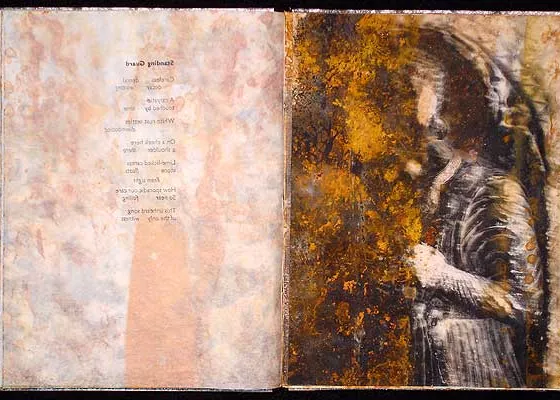Like an archaeological excavation through layers of what has been left behind, this series of artist’s books digs deep to create beauty amid decay and loss. Each of the ten titles (so far) in the Stratigraphic Archives is a new exploration of remnants of the past. Hand printed in limited editions by Brighton Press in San Diego, California, the books feature the work of artist and press director Michele Burgess, who collaborates with several poets. Burgess takes inspiration from an amazing array of sources, making the ephemeral enduring and the damaged lovely.
Repair, the first volume in the series, was made in 2006 in an edition of 30 copies. The simple title suggests a practical fix, yet the book itself is far more complex. Poet and press founder Bill Kelly’s words dovetail with Burgess’s images, shoring up the broken past in an effort to preserve it, while also signaling something more personal. This tactile, profoundly moving book pulls the reader in through strata of word and image. Delicate, translucent paper allows glimpses of what has been seen to resonate with what lies ahead. Crinkly endsheets with holes remind the reader of the strength and fragility of paper, its impermanence and its longevity, and the value of making books by hand.
Each Stratigraphic Archives volume includes a list of sources in the colophon. Words and images in Repair have been inspired by:
- Conservator’s notes on Italian herbal, circa 1500, housed at the Bailey-Howe Library at the University of Vermont
- Bandaged stone figures at the 12th century cloister of St. Trophime in Arles, France
- Photographs from Varsovie reconstruite by Adolf Ciborowski (1962), showing the results of the World War II bombings of Warsaw and the restored city as it looked in 1962
- Visits to sites of forest fires and firestorms in the western US
Repair’s list echoes in the image above. Kelly’s poem, “Standing Guard,” can be seen through the verso of the paper, lingering from the page before. Its final couplets read: “How sporadic our care / So near falling / This unheard song / Of the only witness.”
Possible sources of inspiration for the Stratigraphic Archives can be found anywhere. On a pre-pandemic visit to Wesleyan to show new work, Michele Burgess asked to see “physically censored books … and anything else you might have with human caused or nature caused damage or pernicious alteration.” Out came – among others – a book with handwritten annotations attacking its author, a manuscript with ancient gnawing by a mouse, and a book censored by an anti-papist, who crossed out every appearance of the word “pope.”
All ten published volumes of the Stratigraphic Archives are held by Wesleyan’s Special Collections & Archives. They were purchased directly from Brighton Press using funds from the Hamill endowment, a 1987 bequest from the estates of Chicago antiquarian book sellers Frances Hamill and Margery Barker in honor of then Special Collections librarian Elizabeth Swaim (1933-2000).
This blog post is third in a series on ephemera in Wesleyan’s Special Collections & Archives, presented in conjunction with the Center for the Humanities’ Spring 2021 theme of Ephemera. On March 1st at 6 p.m., Janine Marchessault (York University) will lecture on “Locating Living History in Process Cinema.” Here is the full series calendar.
– Suzy Taraba, Director of Special Collections & Archives
Above image used by permission of the artist.


